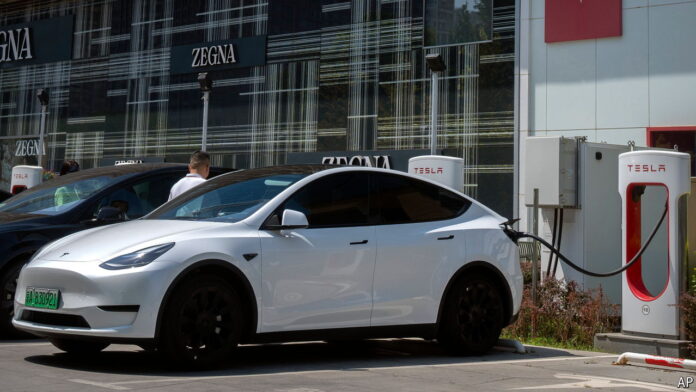The trade conflict between China and the West has expanded to include electric vehicles (EVs), reflecting deeper technological and economic rivalries. Recent months have seen significant escalations, as both sides implement tariffs, launch consultations, and open investigations.
Background of the Trade War
The trade tensions between China and the West have a long history, primarily revolving around issues like intellectual property, technology transfers, and trade imbalances. The EV sector has now become a major battleground due to its significance in the global transition towards sustainable energy and transportation. EVs are not just crucial for future mobility but are also a key area for innovation and economic advancement.
The First Move: America’s 100% Duty on Chinese EVs
In May, the United States imposed a 100% tariff on Chinese EVs, aiming to curb China’s growing influence in the tech sector and protect American manufacturers from what it considers unfair competition. This significant tariff effectively doubles the price of Chinese EVs in the U.S. market, making them less competitive compared to domestic and other international brands.
Canada’s Consultation on “Unfair Chinese Trade Practices”
Following America’s lead, Canada launched a consultation on July 2nd to address “unfair Chinese trade practices” in the EV sector. This move signals Canada’s intent to scrutinize and potentially impose penalties on Chinese EV imports, aligning with the broader Western strategy against China’s trade policies. The consultation process involves collecting evidence and opinions from various stakeholders to evaluate the impact of Chinese practices on the Canadian market.
The EU’s Provisional Tariff: 37.6% on Chinese EVs
On July 4th, the European Union implemented a provisional tariff of 37.6% on Chinese EVs. This significant increase reflects the EU’s concerns about the competitive pressures posed by Chinese manufacturers. The EU is keen on protecting its automotive industry from what it perceives as subsidized and underpriced imports from China.
China’s Retaliation: Anti-Dumping Investigation and Symbolic Swipes
China has not taken these actions lightly. On July 10th, days after initiating an anti-dumping investigation into European brandy—a symbolic counter-move—China’s Ministry of Commerce indicated that it would respond firmly to Western measures. The investigation into European brandy serves as a clear message that China is ready to target high-profile industries in Europe as part of its counter-strategy.
The Stakes for the EV Industry
The stakes in this trade war are exceptionally high for the EV industry. Electric vehicles represent the future of transportation, with significant implications for environmental policy, technological innovation, and economic growth. China has made substantial investments in its EV industry, positioning itself as a global leader in EV production and sales. Chinese companies like BYD, NIO, and Xpeng have gained considerable market share, not only domestically but also internationally.
For Western countries, the rise of Chinese EVs presents both an opportunity and a threat. On one hand, the influx of affordable Chinese EVs can accelerate the adoption of electric vehicles, contributing to global sustainability goals. On the other hand, it poses a significant competitive challenge to Western automakers who are also investing heavily in EV technology.
Economic and Political Implications
The economic implications of this trade war are profound. Tariffs and trade barriers disrupt supply chains, increase costs for consumers, and create uncertainty for manufacturers and investors. For China, the tariffs and investigations can slow down its ambitious plans to dominate the global EV market. For Western countries, retaliatory measures from China could affect a wide range of industries, exacerbating trade tensions.
Politically, the EV trade war reflects deeper geopolitical rivalries. The competition between China and the West is not just about economic dominance but also about technological leadership and strategic influence. The EV sector, with its links to green technology and sustainability, is a critical battleground in this broader contest.
Future Prospects and Strategies
As the EV trade war intensifies, several strategies and outcomes are possible:
1. Negotiation and Compromise: One potential outcome is that the involved parties may seek a negotiated settlement to avoid further economic disruption. This could involve discussions on fair trade practices, subsidies, and market access.
2. Technological Innovation: Both China and Western countries may accelerate their efforts in technological innovation to gain a competitive edge. This includes advancements in battery technology, autonomous driving, and sustainable manufacturing processes.
3. Diversification of Markets: Companies may seek to diversify their markets to mitigate the impact of tariffs. Chinese EV manufacturers might focus on expanding into emerging markets in Asia, Africa, and Latin America, while Western automakers could strengthen their presence in regions less affected by the trade war.
4. Regulatory Harmonization: Efforts to harmonize regulatory standards for EVs across different regions could help reduce trade barriers and facilitate smoother market entry for manufacturers from both sides.
The trade war between China and the West over electric vehicles is a microcosm of the larger economic and technological rivalry between these global powers. The recent flurry of tariffs, consultations, and investigations underscores the high stakes and the intensity of this conflict. As both sides dig in, the future of the EV industry hangs in the balance, with significant implications for global trade, economic policy, and technological innovation.
The outcome of this trade war will not only shape the competitive landscape of the EV market but also influence the broader trajectory of global economic relations in the coming years. Stakeholders in the industry, from manufacturers to policymakers, will need to navigate this complex environment with strategic foresight and adaptability. The resolution of this conflict will require careful negotiation, innovation, and collaboration to ensure a sustainable and prosperous future for the global EV industry.
Disclaimer: The thoughts and opinions stated in this article are solely those of the author and do not necessarily reflect the views or positions of any entities represented and we recommend referring to more recent and reliable sources for up-to-date information.



